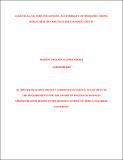| dc.description.abstract | In May 2016, World Health Assembly acknowledged the increasing number of shortages and stock-outs of medicines and vaccines. According to the Busia County’s health and sanitation committee report, residents of the county continue to get poor health services with lack of medical supplies being cited as contributors to poor service delivery. The objective of this study was to evaluate logistical factors influencing accessibility of medicines among public healthcare facilities in Busia County. The specific objectives were to establish the influence of procurement practices, Information Communication Technology (ICT) infrastructure and inventory management on accessibility of medicines in the supply chain among public health care facilities in Busia county. In this study, descriptive research design was adopted and the target population is 85 public healthcare facilities in Busia County. A sample of 70 public healthcare facilities was selected using stratified random sampling technique. Questionnaires were used as research tool, which were administered to the respondents through drop and pick later method. The questionnaire was piloted in order to determine their validity and reliability. Quantitative data collected was analyzed using descriptive and inferential statistics, while qualitative data collected was analyzed using content analysis technique. The findings were presented in form of graphs and tables, and narrations for qualitative findings. The study established that procurement practices and inventory management influenced accessibility of medicines among public healthcare facilities to a very great extent while ICT infrastructure influence accessibility of medicines among public healthcare facilities to a great extent. Further, the Pearson correlation coefficients between procurement practices, ICT infrastructure and inventory management, and accessibility of medicines among public healthcare facilities were 0.512**, 0.296* and 0.324* (P-value = 0.018) which implied positve correlations between logistical factors and accessibility of medicines among public healthcare facilities. The conclusion is that procurement practices and inventory management influence accessibility of medicines among public healthcare facilities to a very great extent while ICT infrastructure influence accessibility of medicines among public healthcare facilities to a great extent. It is recomended to the policy makers to review existing procurement policies to shorten the lengthy processes undertaken in procuring medicine. Further, it is recommended to the county government officials to set aside budget to equip public health facilities with ICT infrastructure. Also, county government should increase its budget allocated for medicine acquisition and distribution. For further studies, a similar study should be extended to private hospitals in order to reveal how logistical factors influencing accessibility of medicines. This will allow for generaliation of the findings and complement the curent study. | en_US |

